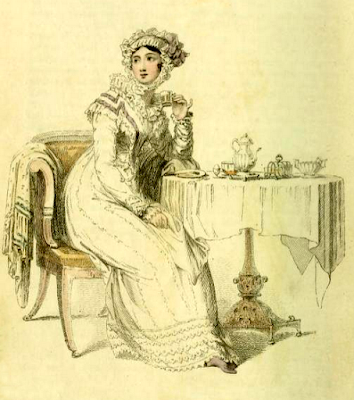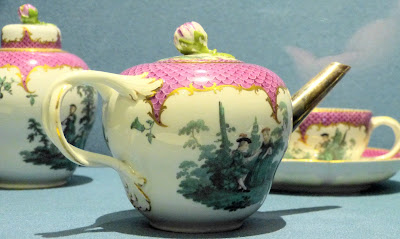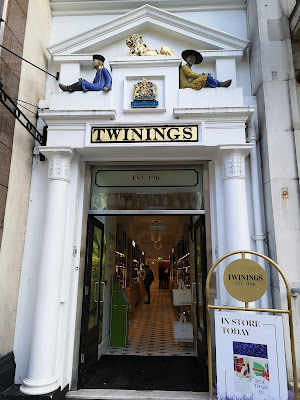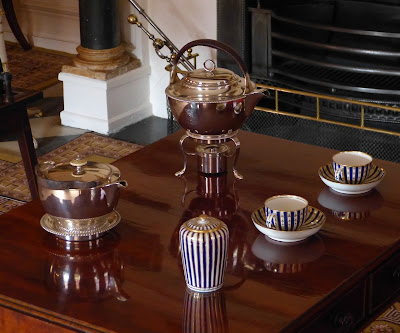 |
| Morning dress from Ackermann's Repository (1822) |
Which do you prefer, tea or coffee? It’s an easy choice for me as I don’t like coffee, but I love tea – black tea or what is sometimes called English breakfast tea. I like it weak with milk and no sugar, and I drink it all day long, from breakfast to bedtime.
But what about during the Regency? Did people drink tea or coffee? And when did they drink these beverages?
 |
| Hester Thrale's Meissen tea service on display at Dr Johnson's House Museum (2015) |
Most of Europe drank coffee, but England was primarily a nation of tea drinkers. Why? Quite possibly as the result of a powerful advertising campaign!
The English’s preference for tea goes back to the mid-1600s. The East India Company had a monopoly on the import of tea from China, and it was therefore in their interests to increase sales of tea. It is likely that the English started drinking more tea at least in part because of East India Company propaganda promoting tea.
Another factor was war with France and Spain which made it hard to get supplies of coffee from the Levant, whilst trade routes from China were reliable. The obvious solution was to drink tea rather than coffee.
 |
| Morning dress from Ackermann's Repository (1814) |
Tea was expensive. The price varied depending on the retailer, the type of tea and the year, but good quality tea was not cheap.
For example, in 1815 the average price per pound of tea paid by the Greenwich Hospital was 6s 3 1/2d.1 In real terms for 2020, this equates to £23.85. This sounds pretty expensive to me – and I imagine the Greenwich Hospital was buying tea at the cheaper end of the market. If you take into account average wages at the time, the real cost of a pound of tea was more like £256.30.2 Definitely a luxury good!
The price of tea was inflated due to high customs and excise duties. As a result, large quantities of tea were smuggled into the country to avoid the taxes. Before the Tea and Window Act of 1784, the tax on tea amounted to 119% of its cost! The Act reduced the tax rate to 12 1/2%, but after this, rates increased again, and smuggling continued.3
Despite its expense, everyone drank tea. Some saw drinking tea as the exclusive privilege of the wealthy and objected to the lower classes adopting the habit. Others, like the Methodists, thought drinking tea should be encouraged in preference to drinking alcohol.
The poor could make a few tea leaves go a long way. I don’t suppose the slightly flavoured water they drank bore much resemblance to the rich infusion of tea served in the houses of the haut ton.
Smouch
Cheaper tea was often smuggled, and may have been smouch rather than pure tea.
Unscrupulous merchants could make a pound of tea go further by mixing it with other, cheaper leaves. Black tea could be mixed with ash leaves to make what was known as smouch. The process sounds revolting as it involved using sheep’s dung to make the smouch look more like tea.
As it was easier to mix other leaves with green tea, a preference for black tea developed.
Licenced to sell
 |
| Entrance to Twinings on Strand (2021) |
Tea was usually bought by the pound, loose from the crate, and wrapped in a screw of paper.
The most common varieties of tea on offer were bohea (black tea) and hyson (green tea). Twinings sold other types such as Pekoe, Imperial and Congo, and could mix the teas together to produce custom blends.
In a letter of 1811, Jane Austen refers to starting her China Tea and finding it very good.4
When did people drink tea?
 |
| Tea caddies and urn at Dunham Massey (2019) |
Those that could afford it added milk or cream, and nearly everyone took sugar until the 1790s when around 300,000 households boycotted sugar in support of the abolitionist movement.
Because tea was expensive, it was often kept locked up in a tea caddy. Hot water was provided by an urn, on or near the table, and the lady of the house, or one of her daughters, was usually responsible for making the tea.
Tea at breakfast time
You can read about Regency breakfast time here.
Don Manuel Alvare Espriella, a Spanish traveller, described his experience of an English breakfast in 1802:
The breakfast-table is a cheerful sight in this country: porcelain of their own manufactory, which excels the Chinese in elegance of form and ornament, is ranged on a Japan waiter, also of the country fabric; for here they imitate every thing. The mistress sits at the head of the board, and opposite to her the boiling water smokes and sings in an urn of Etruscan shape. The coffee is contained in a smaller vase of the same shape, or in a larger kind of tea-pot, wherein the grain-is suspended in a bag; but nothing is so detestable as an Englishman's coffee. The washing of our after-dinner cups would make a mixture as good; the infusion is just strong enough to make the water brown and bitter. This is not occasioned by economy, though coffee is enormously dear, for the people are extravagant in the expences of the table: they know no better; and if you tell them how it ought to be made, they reply, that it must be very disagreeable, and even that if they could drink it so strong, it would prevent them from sleeping. There is besides an act of parliament to prevent the English from drinking good coffee: they are not permitted to roast it them selves, and of course all the fresh and finer flavour evaporates in the warehouse. They make amends however by the excellence of their tea, which is still very cheap, though the ministry, in violation of an explicit bargain, increased the tax upon it four fold, during the last war. This is made in a vessel of silver, or of a fine black porcelain: they do not use boiled milk with it, but cream in its fresh state, which renders it a very delightful beverage.5
I am intrigued that Espriella described tea as very cheap as everything else I’ve read suggests it was expensive, but maybe it was in comparison to what it cost him at home or to the price of coffee.
Jane Austen’s brother Edward preferred coffee. In a letter of 1799, she wrote:
It is rather impertinent to suggest any household care to a housekeeper, but I just venture to say that the coffee-mill will be wanted every day while Edward is at Steventon, as he always drinks coffee for breakfast.6
Tea and coffee after dinner
You can read about Regency dinnertime here.
After dinner, the ladies normally left the gentlemen to drink wine and regrouped in the drawing room.
You can read more about this custom at the end of my blog on drink at the Regency dinner table here.
Tea and coffee were served when the gentlemen re-joined the ladies.
In Pride and Prejudice, Jane Austen describes after-dinner teatime at Longbourn:
The gentlemen came; and she [Elizabeth Bennet] thought he [Mr Darcy] looked as if he would have answered her hopes; but, alas! the ladies had crowded round the table, where Miss Bennet was making tea, and Elizabeth pouring out the coffee, in so close a confederacy that there was not a single vacancy near her which would admit of a chair.7
 |
| The tearoom in Queen Charlotte's Cottage, Kew (2013) |
Queen Charlotte's Cottage, Kew, has a tearoom upstairs. You can read about it here.
In Jane Austen’s Emma, Harriet Smith talks of Mrs Martin
…having a very handsome summer-house in their garden, where some day next year they were all to drink tea:—a very handsome summer-house, large enough to hold a dozen people.8
Inviting people to join you for tea was a popular way of entertaining into the evening. Compared to having someone to dinner, it was less formal, less expensive, conferred less distinction, and was not restricted by the number of people you could get around your dining table.
In Pride and Prejudice, when Elizabeth Bennet goes to visit Charlotte, Mr Collins was hopeful of an invitation to tea:
“I confess,” said he, “that I should not have been at all surprised by her ladyship’s asking us on Sunday to drink tea and spend the evening at Rosings.”9
Charlotte’s sister Maria kept a tally of how often Lady Catherine had invited them to Rosings:
“We have dined nine times at Rosings, besides drinking tea there twice! How much I shall have to tell!”10
In Emma, Jane Austen spontaneously invited her friends to come in for tea:
He [Mr Knightley] had walked up one day after dinner, as he very often did, to spend his evening at Hartfield. Emma and Harriet were going to walk; he joined them; and, on returning, they fell in with a larger party, who, like themselves, judged it wisest to take their exercise early, as the weather threatened rain; Mr and Mrs Weston and their son, Miss Bates and her niece, who had accidentally met. They all united; and, on reaching Hartfield gates, Emma, who knew it was exactly the sort of visiting that would be welcome to her father, pressed them all to go in and drink tea with him. The Randalls party agreed to it immediately; and after a pretty long speech from Miss Bates, which few persons listened to, she also found it possible to accept dear Miss Woodhouse’s most obliging invitation.11
Jane Austen often wrote of drinking tea with friends. In a letter in April 1811 she wrote:
We drank tea again yesterday with the Tilsons, and met the Smiths. – I find all these little parties very pleasant.12
 |
| Tea things in Queen Charlotte's drawing room, Kew Palace (2013) |
Of course, there were tea addicts, like Samuel Johnson, who was renowned for drinking tea at all times of the day.
In a response to a criticism of tea-drinking written in 1757, Johnson admitted that he was
…a hardened and shameless tea-drinker, who has, for twenty years, diluted his meals with only the infusion of this fascinating plant; whose kettle has scarcely time to cool; who with tea amuses the evening, with tea solaces the midnight, and, with tea, welcomes the morning.13
That sounds like
me…
If you have enjoyed this blog and want to encourage me and help me to keep making my research freely available, please buy me a virtual cup of coffee by clicking the button below.
Notes
- These figures are from Levi, Leone, Wages and Earnings of the Working Classes (1867).
- These figures are from The Measuring Worth website.
- These figures are from Wisset, Robert, A View of the rise, progress and present state of the Tea Trade in Europe (1801).
- Austen, Jane, Jane Austen's Letters, Collected and Edited by Le Faye, Deirdre (Oxford University Press, 1995).
- Espriella, Don Manuel Alvare, Letters from England, translated from the Spanish by Robert Southey 3rd edition (1814) Volume 1.
- Austen op cit.
- Austen, Jane, Pride and Prejudice (1813, London).
- Austen, Jane, Emma (1815, London).
- Austen, Jane, Pride and Prejudice (1813, London).
- Ibid.
- Austen, Jane, Emma (1815, London).
- Austen, Jane, Jane Austen's Letters, Collected and Edited by Le Faye, Deirdre (Oxford University Press, 1995).
- Johnson, Samuel, Works of Samuel Johnson Vol 6/11 (1825)
Sources used include:
Austen, Jane, Emma (1815, London)
Austen, Jane, Jane Austen's Letters, Collected and Edited by Le Faye, Deirdre (Oxford University Press, 1995)
Austen, Jane, Pride and Prejudice (1813, London)
Cruickshank, Dan and Burton, Neil, Life in the Georgian City (1990)
Espriella, Don Manuel Alvare, Letters from England, translated from the Spanish by Robert Southey 3rd edition (1814) Volume 1
Johnson, Samuel, Works of Samuel Johnson Vol 6/11 (1825)
Levi, Leone, Wages and Earnings of the Working Classes (1867)
Pettigrew, Jane and Richardson, Bruce, A Social History of Tea (2014)
Twining, Richard, Observations on the Tea and Window Act and on the Tea Trade (1785)
Twinings website
Wisset, Robert, A View of the rise, progress and present state of the Tea Trade in Europe (1801)


No comments:
New comments are not allowed.